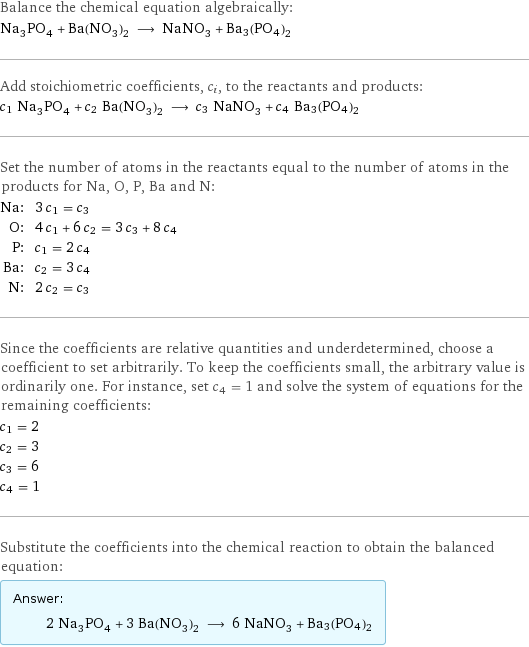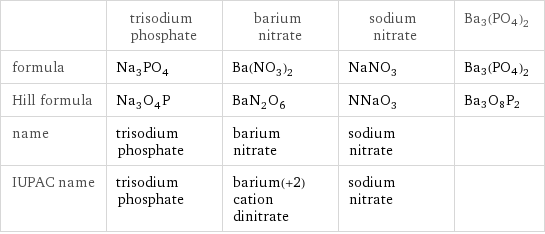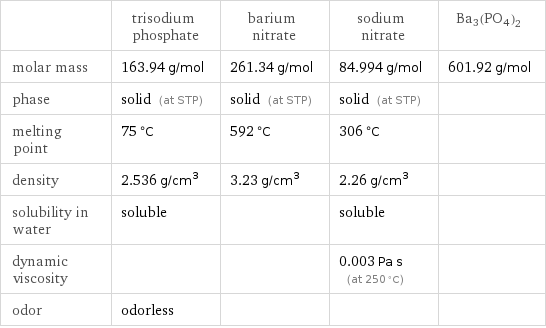Input interpretation

Na_3PO_4 trisodium phosphate + Ba(NO_3)_2 barium nitrate ⟶ NaNO_3 sodium nitrate + Ba3(PO4)2
Balanced equation

Balance the chemical equation algebraically: Na_3PO_4 + Ba(NO_3)_2 ⟶ NaNO_3 + Ba3(PO4)2 Add stoichiometric coefficients, c_i, to the reactants and products: c_1 Na_3PO_4 + c_2 Ba(NO_3)_2 ⟶ c_3 NaNO_3 + c_4 Ba3(PO4)2 Set the number of atoms in the reactants equal to the number of atoms in the products for Na, O, P, Ba and N: Na: | 3 c_1 = c_3 O: | 4 c_1 + 6 c_2 = 3 c_3 + 8 c_4 P: | c_1 = 2 c_4 Ba: | c_2 = 3 c_4 N: | 2 c_2 = c_3 Since the coefficients are relative quantities and underdetermined, choose a coefficient to set arbitrarily. To keep the coefficients small, the arbitrary value is ordinarily one. For instance, set c_4 = 1 and solve the system of equations for the remaining coefficients: c_1 = 2 c_2 = 3 c_3 = 6 c_4 = 1 Substitute the coefficients into the chemical reaction to obtain the balanced equation: Answer: | | 2 Na_3PO_4 + 3 Ba(NO_3)_2 ⟶ 6 NaNO_3 + Ba3(PO4)2
Structures

+ ⟶ + Ba3(PO4)2
Names

trisodium phosphate + barium nitrate ⟶ sodium nitrate + Ba3(PO4)2
Equilibrium constant
![Construct the equilibrium constant, K, expression for: Na_3PO_4 + Ba(NO_3)_2 ⟶ NaNO_3 + Ba3(PO4)2 Plan: • Balance the chemical equation. • Determine the stoichiometric numbers. • Assemble the activity expression for each chemical species. • Use the activity expressions to build the equilibrium constant expression. Write the balanced chemical equation: 2 Na_3PO_4 + 3 Ba(NO_3)_2 ⟶ 6 NaNO_3 + Ba3(PO4)2 Assign stoichiometric numbers, ν_i, using the stoichiometric coefficients, c_i, from the balanced chemical equation in the following manner: ν_i = -c_i for reactants and ν_i = c_i for products: chemical species | c_i | ν_i Na_3PO_4 | 2 | -2 Ba(NO_3)_2 | 3 | -3 NaNO_3 | 6 | 6 Ba3(PO4)2 | 1 | 1 Assemble the activity expressions accounting for the state of matter and ν_i: chemical species | c_i | ν_i | activity expression Na_3PO_4 | 2 | -2 | ([Na3PO4])^(-2) Ba(NO_3)_2 | 3 | -3 | ([Ba(NO3)2])^(-3) NaNO_3 | 6 | 6 | ([NaNO3])^6 Ba3(PO4)2 | 1 | 1 | [Ba3(PO4)2] The equilibrium constant symbol in the concentration basis is: K_c Mulitply the activity expressions to arrive at the K_c expression: Answer: | | K_c = ([Na3PO4])^(-2) ([Ba(NO3)2])^(-3) ([NaNO3])^6 [Ba3(PO4)2] = (([NaNO3])^6 [Ba3(PO4)2])/(([Na3PO4])^2 ([Ba(NO3)2])^3)](../image_source/cbf280f5f4e3fbe65e5b019256ffa5c7.png)
Construct the equilibrium constant, K, expression for: Na_3PO_4 + Ba(NO_3)_2 ⟶ NaNO_3 + Ba3(PO4)2 Plan: • Balance the chemical equation. • Determine the stoichiometric numbers. • Assemble the activity expression for each chemical species. • Use the activity expressions to build the equilibrium constant expression. Write the balanced chemical equation: 2 Na_3PO_4 + 3 Ba(NO_3)_2 ⟶ 6 NaNO_3 + Ba3(PO4)2 Assign stoichiometric numbers, ν_i, using the stoichiometric coefficients, c_i, from the balanced chemical equation in the following manner: ν_i = -c_i for reactants and ν_i = c_i for products: chemical species | c_i | ν_i Na_3PO_4 | 2 | -2 Ba(NO_3)_2 | 3 | -3 NaNO_3 | 6 | 6 Ba3(PO4)2 | 1 | 1 Assemble the activity expressions accounting for the state of matter and ν_i: chemical species | c_i | ν_i | activity expression Na_3PO_4 | 2 | -2 | ([Na3PO4])^(-2) Ba(NO_3)_2 | 3 | -3 | ([Ba(NO3)2])^(-3) NaNO_3 | 6 | 6 | ([NaNO3])^6 Ba3(PO4)2 | 1 | 1 | [Ba3(PO4)2] The equilibrium constant symbol in the concentration basis is: K_c Mulitply the activity expressions to arrive at the K_c expression: Answer: | | K_c = ([Na3PO4])^(-2) ([Ba(NO3)2])^(-3) ([NaNO3])^6 [Ba3(PO4)2] = (([NaNO3])^6 [Ba3(PO4)2])/(([Na3PO4])^2 ([Ba(NO3)2])^3)
Rate of reaction
![Construct the rate of reaction expression for: Na_3PO_4 + Ba(NO_3)_2 ⟶ NaNO_3 + Ba3(PO4)2 Plan: • Balance the chemical equation. • Determine the stoichiometric numbers. • Assemble the rate term for each chemical species. • Write the rate of reaction expression. Write the balanced chemical equation: 2 Na_3PO_4 + 3 Ba(NO_3)_2 ⟶ 6 NaNO_3 + Ba3(PO4)2 Assign stoichiometric numbers, ν_i, using the stoichiometric coefficients, c_i, from the balanced chemical equation in the following manner: ν_i = -c_i for reactants and ν_i = c_i for products: chemical species | c_i | ν_i Na_3PO_4 | 2 | -2 Ba(NO_3)_2 | 3 | -3 NaNO_3 | 6 | 6 Ba3(PO4)2 | 1 | 1 The rate term for each chemical species, B_i, is 1/ν_i(Δ[B_i])/(Δt) where [B_i] is the amount concentration and t is time: chemical species | c_i | ν_i | rate term Na_3PO_4 | 2 | -2 | -1/2 (Δ[Na3PO4])/(Δt) Ba(NO_3)_2 | 3 | -3 | -1/3 (Δ[Ba(NO3)2])/(Δt) NaNO_3 | 6 | 6 | 1/6 (Δ[NaNO3])/(Δt) Ba3(PO4)2 | 1 | 1 | (Δ[Ba3(PO4)2])/(Δt) (for infinitesimal rate of change, replace Δ with d) Set the rate terms equal to each other to arrive at the rate expression: Answer: | | rate = -1/2 (Δ[Na3PO4])/(Δt) = -1/3 (Δ[Ba(NO3)2])/(Δt) = 1/6 (Δ[NaNO3])/(Δt) = (Δ[Ba3(PO4)2])/(Δt) (assuming constant volume and no accumulation of intermediates or side products)](../image_source/32fec65e8815d84a00fc4f788f19af34.png)
Construct the rate of reaction expression for: Na_3PO_4 + Ba(NO_3)_2 ⟶ NaNO_3 + Ba3(PO4)2 Plan: • Balance the chemical equation. • Determine the stoichiometric numbers. • Assemble the rate term for each chemical species. • Write the rate of reaction expression. Write the balanced chemical equation: 2 Na_3PO_4 + 3 Ba(NO_3)_2 ⟶ 6 NaNO_3 + Ba3(PO4)2 Assign stoichiometric numbers, ν_i, using the stoichiometric coefficients, c_i, from the balanced chemical equation in the following manner: ν_i = -c_i for reactants and ν_i = c_i for products: chemical species | c_i | ν_i Na_3PO_4 | 2 | -2 Ba(NO_3)_2 | 3 | -3 NaNO_3 | 6 | 6 Ba3(PO4)2 | 1 | 1 The rate term for each chemical species, B_i, is 1/ν_i(Δ[B_i])/(Δt) where [B_i] is the amount concentration and t is time: chemical species | c_i | ν_i | rate term Na_3PO_4 | 2 | -2 | -1/2 (Δ[Na3PO4])/(Δt) Ba(NO_3)_2 | 3 | -3 | -1/3 (Δ[Ba(NO3)2])/(Δt) NaNO_3 | 6 | 6 | 1/6 (Δ[NaNO3])/(Δt) Ba3(PO4)2 | 1 | 1 | (Δ[Ba3(PO4)2])/(Δt) (for infinitesimal rate of change, replace Δ with d) Set the rate terms equal to each other to arrive at the rate expression: Answer: | | rate = -1/2 (Δ[Na3PO4])/(Δt) = -1/3 (Δ[Ba(NO3)2])/(Δt) = 1/6 (Δ[NaNO3])/(Δt) = (Δ[Ba3(PO4)2])/(Δt) (assuming constant volume and no accumulation of intermediates or side products)
Chemical names and formulas

| trisodium phosphate | barium nitrate | sodium nitrate | Ba3(PO4)2 formula | Na_3PO_4 | Ba(NO_3)_2 | NaNO_3 | Ba3(PO4)2 Hill formula | Na_3O_4P | BaN_2O_6 | NNaO_3 | Ba3O8P2 name | trisodium phosphate | barium nitrate | sodium nitrate | IUPAC name | trisodium phosphate | barium(+2) cation dinitrate | sodium nitrate |
Substance properties

| trisodium phosphate | barium nitrate | sodium nitrate | Ba3(PO4)2 molar mass | 163.94 g/mol | 261.34 g/mol | 84.994 g/mol | 601.92 g/mol phase | solid (at STP) | solid (at STP) | solid (at STP) | melting point | 75 °C | 592 °C | 306 °C | density | 2.536 g/cm^3 | 3.23 g/cm^3 | 2.26 g/cm^3 | solubility in water | soluble | | soluble | dynamic viscosity | | | 0.003 Pa s (at 250 °C) | odor | odorless | | |
Units
